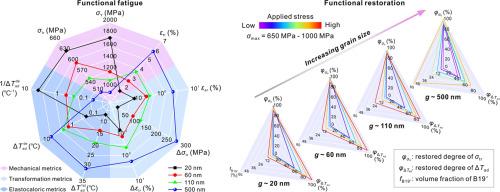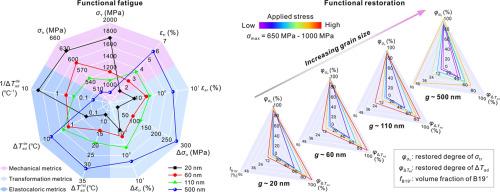超弹性NiTi形状记忆合金的功能疲劳与恢复
IF 12.8
1区 材料科学
Q1 ENGINEERING, MECHANICAL
引用次数: 0
摘要
niti基形状记忆合金(sma)的功能疲劳是其在各种技术中广泛应用的一个关键障碍,目前对其机理的了解还不完整。本文研究了在不同最大外加应力(σmax)条件下,具有不同晶粒尺寸的超弹性NiTi sma材料的功能疲劳及其恢复。结果表明,较大的晶粒尺寸和较大的σmax显著加剧了疲劳引起的位错密度增加和马氏体保留引起的运动不可逆性。结果表明,循环后的功能恢复可以通过简单的过热处理(“愈合”)来实现,这将保留的马氏体恢复为奥氏体,以供后续转变,同时保留位错。残余马氏体降低循环过程中临界正向转变应力,但其作用完全可逆,与晶粒尺寸和σmax无关。位错和保留的马氏体都损害了材料的循环转变能力,导致弹热降解。残余马氏体的贡献随着σmax的增大而增大,最终超过位错的影响;晶粒尺寸的细化加速了这种转变。这项工作为NiTi sma中功能疲劳和恢复的微观机制提供了定量的见解,促进了可持续弹热技术的发展。本文章由计算机程序翻译,如有差异,请以英文原文为准。


Functional fatigue and restoration in superelastic NiTi shape-memory alloys
Functional fatigue in NiTi-based shape-memory alloys (SMAs), a critical barrier to their widespread adoption for a variety of technologies, remains a key challenge with incomplete mechanistic understanding. Here we investigate functional fatigue and its restoration in superelastic NiTi SMAs with wide-ranging grain sizes and subjected to elastocaloric cycling under varying maximum applied stresses (σmax). Results show that larger grain sizes and/or higher σmax significantly exacerbate the kinematic irreversibility caused by the fatigue-induced increased dislocation density and martensite retention. It is demonstrated that functional restoration can be achieved through a simple overheating treatment (‘healing’) after cycling, which reverts the retained martensite into austenite for subsequent transformation while preserving dislocations. Retained martensite alone lowers the critical forward transformation stress during cycling, but its effect is fully reversible by healing, irrespective of grain size and σmax. Both dislocations and retained martensite impair the cyclic transformation capacity of the material, leading to elastocaloric degradation. The contribution of retained martensite, which can be revoked by healing for elastocaloric restoration, increases with σmax and eventually outweighs the influence of dislocations; refinement in the grain size accelerates this transition. The work provides quantitative insights into the micro-mechanisms underlying functional fatigue and restoration in NiTi SMAs, advancing the development of sustainable elastocaloric technologies.
求助全文
通过发布文献求助,成功后即可免费获取论文全文。
去求助
来源期刊

International Journal of Plasticity
工程技术-材料科学:综合
CiteScore
15.30
自引率
26.50%
发文量
256
审稿时长
46 days
期刊介绍:
International Journal of Plasticity aims to present original research encompassing all facets of plastic deformation, damage, and fracture behavior in both isotropic and anisotropic solids. This includes exploring the thermodynamics of plasticity and fracture, continuum theory, and macroscopic as well as microscopic phenomena.
Topics of interest span the plastic behavior of single crystals and polycrystalline metals, ceramics, rocks, soils, composites, nanocrystalline and microelectronics materials, shape memory alloys, ferroelectric ceramics, thin films, and polymers. Additionally, the journal covers plasticity aspects of failure and fracture mechanics. Contributions involving significant experimental, numerical, or theoretical advancements that enhance the understanding of the plastic behavior of solids are particularly valued. Papers addressing the modeling of finite nonlinear elastic deformation, bearing similarities to the modeling of plastic deformation, are also welcomed.
 求助内容:
求助内容: 应助结果提醒方式:
应助结果提醒方式:


